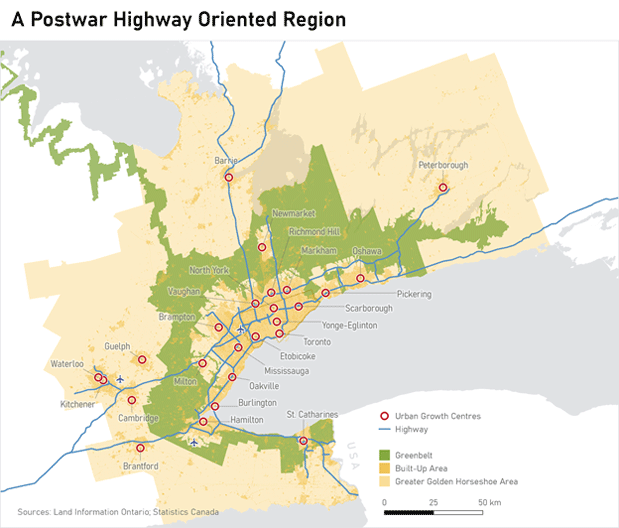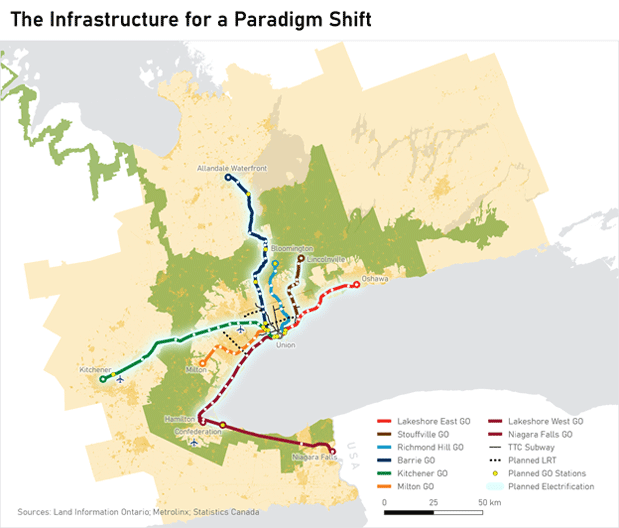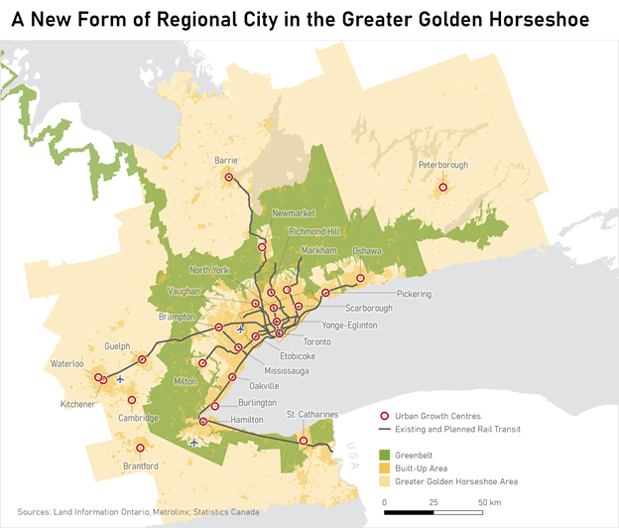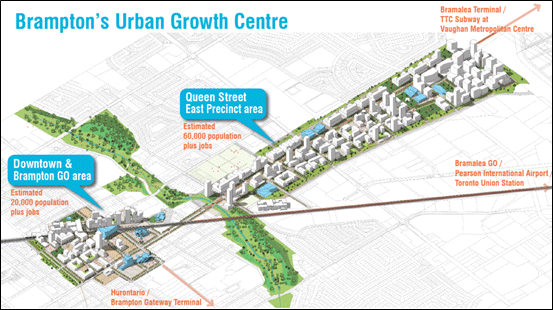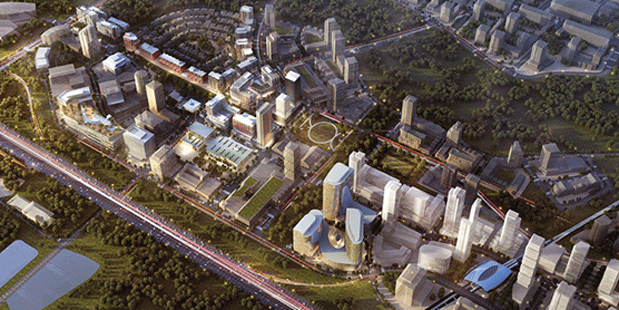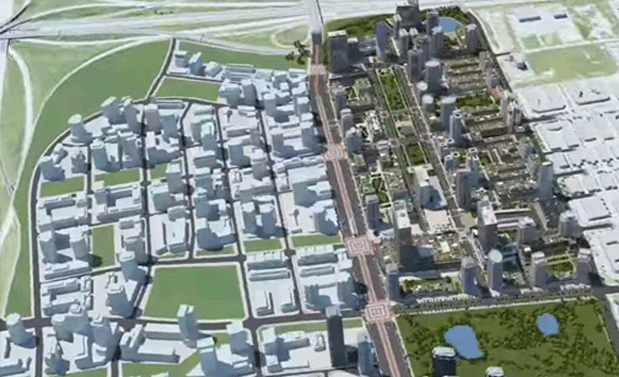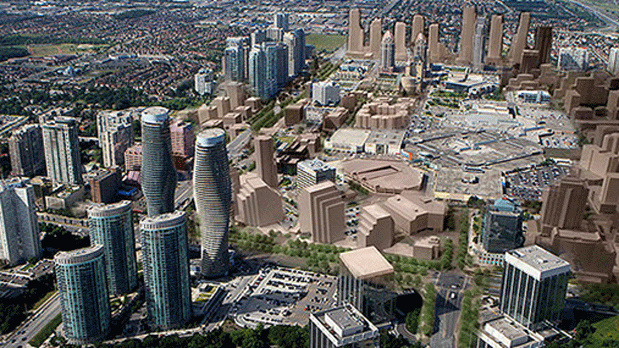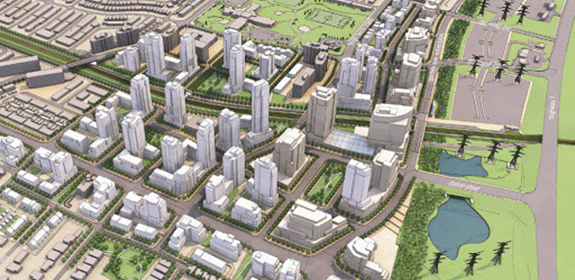Driving Dense and Sustainable Growth in Toronto’s Thriving Suburbs
Ken Greenberg is an urban designer, a teacher, a writer, a former director of urban design and architecture for the city of Toronto, and principal of Greenberg Consultants.
During a period of phenomenal growth in which Toronto has had more cranes in the sky than any other North American city, a new form of city region with multiple urban centers has started to emerge in the Greater Toronto Area (GTA). This new city region is propelled by powerful economic and social forces and spurred by the imperative of a more sustainable future.
A note from ULI CEO Ed Walter about the 2020 ULI Spring Meeting.
This ambitious growth is motivated by population projections. Over the next two decades, the province of Ontario, home to the GTA, will grow by over 4 million people. The Greater Toronto Area is expected to grow from 6.35 million today to more than 10 million residents by midcentury, making it one of the fastest-growing regions in the developed world.
A critical question facing the region is about housing nearly 3 million additional people. Until recently, growth in Toronto was characterized by auto-dependent sprawl and widely dispersed single-purpose land uses along major arterials and highways, spread out over 2,300 square miles (6,000 sq km) with population densities averaging only 2,800 people per square mile. This post–World War II paradigm is no longer viable, and the region is moving away from the urban form adapted to automobile use with vast amounts of parking and segregated places of living, working, and shopping of its past.
Going forward, growth in the GTA will increasingly hug transit lines, with residents living in more compact and walkable urban neighborhoods. The key framework for the future of the GTA is higher-order transit, funded in large part by the province of Ontario’s $28 billion Regional Transit Plan, announced in April 2019.
The transition to a more sustainable region, defined by transit-oriented development, has already started in the municipalities making up the GTA. New “downtown centers” and densifying neighborhoods throughout the region are taking shape along suburban arterials served by new light rail and bus rapid transit (BRT), at commuter rail stations with new all-day two-way service, and in repurposed malls and obsolescent industrial sites. Virtually every municipality in the GTA has a number of such developments underway. Together they are producing a very different metropolitan form, transforming the GTA into an interconnected, multicentered, transit-oriented city region.
To date, dispersed, low-density development has followed the lines of major highways.
The new region will be defined by higher-order transit.
Plans are in place to transform the Toronto region into an interconnected, multicentered, transit-oriented city region.
Here is a sampling of projects in progress at key transportation hubs that are creating “spoke-and-hub anchors” for a new multicentered city region.
Brampton Downtown and Queen Street Precinct
Brampton’s urban growth center covers 224 hectares (553 acres) and serves a population of 80,000. Plans were identified through Brampton City Council’s endorsement of the Brampton 2040 Vision in 2018, and Queen Street Precinct Plan in 2020. Downtown Brampton will be enabled by all-day two-way commuter rail, bus rapid transit, commitments from the province of Ontario for new light rail, and an airport-link service. The Queen Street Corridor is planned to attract significant growth through revitalization and infill/intensification that will continue the transformation of the area into a transit- and pedestrian-oriented district of walkable neighborhoods. The plans for this urban growth center are being implemented through a combination of precinct plans to set a clear urban vision, and a development permit system to streamline approvals.
Markham Centre
The planning for Markham Centre was approved in Markham’s Future Official Plan in 2014. It is served by inter-regional rail and bus service from three transit agencies. Markham Centre will also be served by a new proposed BRT. Markham’s population is expected to rise from 328,966 in 2016 to 421,600 by 2031. The employment forecast for Markham Centre is 255,500 in 2036 and 275,700 in 2041 from 159,640 in 2016.
Vaughan Metropolitan Centre
The Vaughan Metropolitan Centre Secondary Plan was approved in 2017. It aims to guide the future growth and development of the Vaughan Metropolitan Centre over a period of 20 to 25 years through outlining its planning framework and policies. The area is served by the recent extension of the Toronto subway, and improvements to regional transit are anticipated. The target population and employment rate for the Vaughan metropolitan center is 200 people and jobs per hectare by 2030.
Mississauga City Centre
The city of Mississauga’s Downtown Core Local Area Plan approved the creation of a new downtown through repurposing lands around a shopping mall covering an area of 50.5 acres (20.4 ha). Mississauga City Centre will be served by light-rail transit and BRT. The city of Mississauga aims to achieve a gross density of 300 to 400 residents per hectare with a 1:1 population to employment ratio across the downtown area by 2031.
Richmond Hill/Langstaff Urban Growth Centre
The Richmond Hill/Langstaff Gateway area is a designated Provincial Urban Growth Centre under the Growth Plan for the Greater Golden Horseshoe and an identified Regional Centre within the York Region Official Plan. The center is a planned high-density mixed-use community, a commuter rail and intermodal transit hub, and an important component of York Region’s growth management strategy. The Regional Centre is planned to accommodate 48,000 people and 31,000 jobs by 2031. The Regional Centre is also the terminus of the future Toronto subway extension and part of the planned regional BRT transitway.
Sustainability Benefits
As these examples illustrate, work is underway to create walkable, mixed-use, “complete” communities throughout the region. At the heart of the transformation underway is a goal to reduce automobile dependence through TOD, which comes with a host of other benefits.
New developments are aiming for “the 20-minute neighborhood” where community hubs encompassing schools, community centers and services, libraries, daycare, health care, cultural, and recreational facilities serve residents within a 20-minute walking radius. (TOD will also help make active transportation feasible and attractive for short trips close to home.) Nearly all the new urban centers and neighborhoods mentioned above will also create vibrant new public spaces as a central feature, to support healthy, active lifestyles and greater social connection.
Because of their scale, these new regional centers and neighborhoods open up possibilities to introduce significant innovations in sustainability, including district energy generation and energy capture, new ways of dealing with stormwater and flood protection, and systems for waste treatment and collection. Coupled with ways of living that are inherently more sustainable and less auto-dependent, these emerging areas will play a major role in reducing the carbon footprint of the entire region and building environmental resilience.
Getting to the Future
The Toronto region, already an integrated economy, is well on its way to a more sustainable future in which it will welcome millions of new residents. This growth in population will come from all over the world, continuing Toronto’s role as an arrival city for immigrants, and one of the most diverse urban populations in the world. In fact, the way in which Canada has integrated new arrivals in Toronto has been our city region’s greatest source of prosperity and is why it continues to grow and attract employers, investors, and talented individuals to locate here. (Case in point is Toronto’s pool of tech talent, which grew at the fastest pace of all 50 North American markets measured, adding 80,100 tech jobs in the past five years—a 54 percent increase.) This success is not to be taken for granted, and depends to a high degree on where and how people are housed, and the quality and availability of a supportive social infrastructure.
To fully capture the economic and social benefits of a strong urban region, Toronto will need to solve complex problems, like increasing improving transit service so that people can live and work in all parts of the city region, and ensuring that a combination of market-rate, subsidized, and partially subsidized housing options are “baked in” to all new urban neighborhoods to preserve affordability. GTA municipalities will also need to identify how they can become more viable places for working and shopping, as preferences and habits in employment and retail continue to shift in the new economy.
Getting to the future, and realizing the ambitious form of new urbanism envisioned for the Toronto region, will require change, determination, and collaboration from multiple levels of government, the development industry, community organizations, and an array of civil society actors and relevant agencies.
